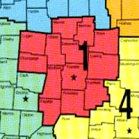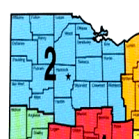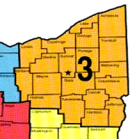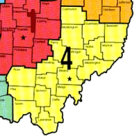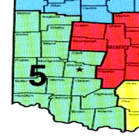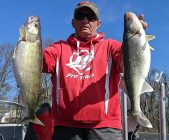Looking for seasonal bass fishing tips? Here is a great article chock full of bass behaviors meant to help you understand where bass go when the water temperatures drop.
By Jim Porter
Of all nature’s forces which affect bass, seasonal aspects have the most pronounced impacts. It can be truly said that the habits and lifestyles of most fish, the bass included, are ruled by the weather. Now this might seem to be a bit of an extreme observation, given that fish live beneath the protective surface of the water. However, it is very true and, during this discussion, we hope to shed some light on the subject.
As you go through this material, please keep in mind the number one rule that has been applicable to all fishermen since time immemorial: `Catching fish is very easy; finding them is the hard part. In order to overcome that major difficulty of finding the bass, we must first have an understanding of what goes on in his watery world and how he reacts to the various conditions and changes. As with all of God’s creatures, the actions and reactions of the bass are controlled by two instinctive goals– survival (food, comfort, safety) and reproduction of its own kind. The intent of this article is to provide insight regarding bass actions/reactions, as influenced by the Fall seasonal cycles.
Summer To Fall
In order to fully understand what takes place in the world of the bass as he moves from Fall into Winter, we need to take a quick look at the earlier transition from Summer into the Fall posture. Since this transition can support an entire series, itself, we will necessarily be brief and omit going into detail.
Summer was a time of heavy schooling, strong movements and much feeding. With the rigors of the spawn left behind, the majority of the bass gathered in open-water school groups and passed the summer months leisurely feeding on the new hatches of bait fish and other food choices. In order to maximize the aspects of comfort (primarily in avoidance of the strong penetration of the nearly-overhead Summer sunlight), Summer bass were generally found on mid-depth structures, rather than in the shallows.
Also, these locations were usually near channel edges and other structures influenced, to some degree, by current flow. (The availability of some moving water is a guarantee of additional comfort in continual food supplies and good oxygen content, with the latter often being a problem during the hot months. Current causes mixing of the water and adds oxygen, while preventing stratification layering by temperature/oxygen content.) With the waters warm and, consequently, body metabolism high, feeding was a regular activity.
The first cooling days of the approaching Fall season triggered an instinctive reaction in the bass to consider the impending preparation for the winter period. This preparation basically consists of a period of very heavy feeding, attempting to lay in as much strength and body fat as possible to provide sustainment through a generally dormant Winter. It also provides the basic body quality to support the initial internal preparation for spawning, a function that actually begins in mid-Winter in the females. If we will note, this response is not unlike most animals, birds and reptiles.
Moving To The Shallows
As the waters begin to lose the heat of Summer, the penetrating sun is no longer directly overhead and the oxygen level is again supportive of life in the shallows. The smaller elements of the food chain begin to emerge in the shallows. The larger predators, likewise, follow and the shallow zones again become the primary areas of activity.
Recalling the food value associated with current flow, we note that the bass initially starts his movements to the shallow zones by entering feeder tributaries and progressing upstream. This movement sequence may not have to take the fish far, in that he is only looking for feeding flats and cover areas in four to ten feet of water.
A point to note regarding the actual depth of the feeding locations involves the normal clarity of the waters you are fishing. The four to ten foot range we spoke to is the `normal’ during the fall for most bodies of water in the eastern half of the country, those having some degree of natural coloration.
However, on exceptionally clear waters, such as Georgia’s Lake Lanier or Alabama’s Lewis Smith Lake, the general depth of bass activity and life functions will always be deeper. On those lakes, we would probably extend the expected fall depth range down to 12 to 18 feet. We often refer to this factor as the `pattern depth’, and it provides us with a logical guide and starting point in our determination as to where the bass might be on a given body of water. The `pattern depth’ is defined as the depth the majority of school bass can be expected to be, given the normal clarity of the water and the seasonal conditions.
Now the bass is in the Fall posture and we can begin our discussion of his current actions and the later transition to Winter.
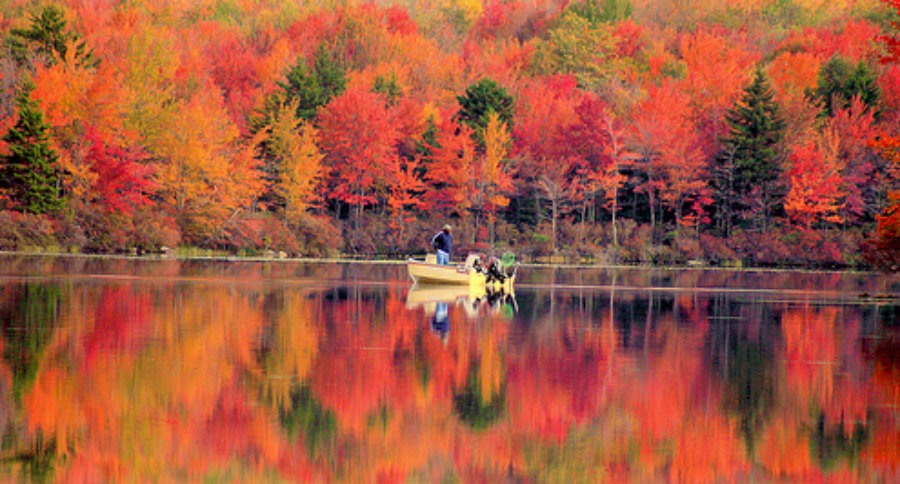
Fall To Winter Transition
Once the water temperatures have dropped into the mid-60 degree range, the bass family can be expected to have progressed to the fall feeding locations. As we initially said, these areas are generally characterized as being associated with feeder tributaries, having some amount of cover (to support the smaller elements of the food chain, not to hide the bass), and be about four to ten feet in depth. Normally, these locations will be adjacent to the deepest available water in the area, most probably a submerged channel.
Here, we should take note of a `fine’ detail. Recall, if you will, that spawning bass are the least predictable in regards to where they may be found. Granted, they will be on clean, hard-bottomed areas, out of current influence and in fairly shallow water. But, they do not adhere to the primary bass rule of always remaining very near a deep water access, or safety/escape zone. (I suppose love makes all of us do strange things, though.) At all other times of year, deep water is a firm requirement regarding bass locations, the Fall being no exception.
Therefore, we are able to make three initial determinations to help us locate fall bass rapidly:
– Locate the feeder tributaries
– Look for cover locations along, or very near, the submerged channel edge
– Key to generally four to ten feet of water (or the appropriately-determined `pattern depth’ for the target waters.
Once he has located the proper areas and if the food supplies are there, the bass will remain until the waters cool into the mid-50 degree range. The period is characterized by heavy feeding, a good amount of surface activity and little change of location, save that required to follow the food supply. The peak of this Fall feeding spree usually lasts for about three weeks, with short interruptions by weather fronts.
As the nights become longer, the temperatures more crisp and the waters start to cool, the bass’ instincts caution him that Winter is getting closer and he must begin to adjust for survival. Suddenly, we no longer are able to find him around the shallow cover. He appears to have `pulled up stakes’ and moved on to greener pastures, wherever they may be.
(This particular happening always seems to coincides with the departure of most anglers from the waters for the Winter!)
Well, actually, it is what CAUSES the anglers to leave. On the mistaken belief that the bass have `stopped biting because it is getting too cold’, many fishermen winterize their boats and actually miss some of the finest angling of the entire year.
Where Did They Go?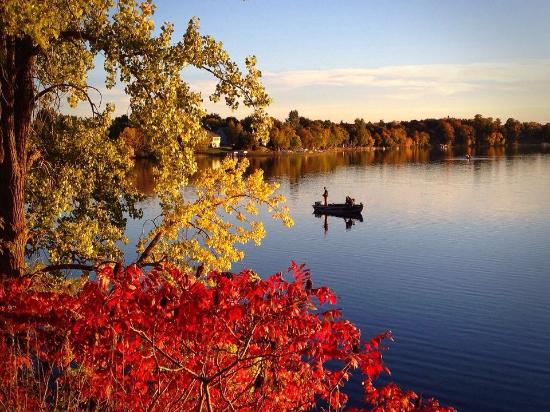
The bass NEVER `quit biting’. That’s the oldest and most incorrect notion in the world of fishing. In 99 of 100 cases, fish do not ever fully stop feeding (biting, if you prefer). The reason they are not caught is because they are no longer where the angler is drowning his bait or lure.
In response to some influence, they have simply moved. In our case, with the peak of the Fall feeding binge over, most bass are beginning a gradual migration towards the deeper waters. But, they will still be feeding along the way. This migration is gradual and takes place over loosely-defined period, dependent in part upon the rapidity with which full-scale winter sets in and its intensity.
As the water temperatures continue to drop, life begins to vacate the shallows and head for the more stable conditions of the deep water. Yes, it will be cold in the depths, but it will still be warmer than the shallow areas and there will be little, if any, fluctuation of conditions.
As the fish move deeper, generally following defined, major structure features, the singles and small groups tend to join and form large schools. The school is searching for something and, by understanding what that `something’ is and the associated conditions, the angler is able to find Winter bass nearly as easily as he does at other times of the year.
The bass school is looking for an isolated, well-defined piece of hard, clean structure for use as a reference point to hold the school together. The associated conditions required are two-fold: no influencing water currents, and an area deep enough to preclude influence from the volatile Winter weather and its turbulence.
I expect the reader, after having it called to his attention, easily recognizes the depth requirement for
environmental stabilization and the use of the structure as a reference point. However, the additional desire for an absence of current flow possibly deserves a few words of explanation.
Bass, like all cold-blooded creatures, undergo a substantial reduction in their bodily function (metabolism) rate as the temperature of their immediate surroundings drops. Accordingly, there is a corresponding reduction in the amount of food and oxygen intake required to sustain life. Although it is not actually what can be called hibernation, a cold-water bass does enter a state of relative dormancy, during which he moves as little as possible and is very lethargic. During the warm months, current flow was a `friend’ which brought food and insured oxygen. However, those are not primary concerns during the winter. In addition, current would force the bass to expend valuable energy to retain his positioning. Therefore, it is obviously to be avoided.
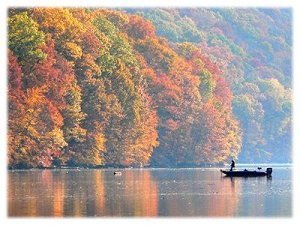 Let’s recap where we have been and where we are now, regarding the transition of the bass from a Fall to Winter posture.
Let’s recap where we have been and where we are now, regarding the transition of the bass from a Fall to Winter posture.
We discussed where the bass would most likely be during the Fall season and, very briefly, covered how he transitions from Summer into that fall posture. Then, we talked about the characteristics of the fall locations and how those characteristics helped us to identify potential fishing locations with some degree of confidence. Next, our dissertation went into the gradual abandonment of the Fall positioning and the movement to the deep wintering areas. From this information, the reader should now have an understanding of what is happening in the world of the bass and why. He also should be able to recognize the associated conditions and make reasonably accurate assumptions as to where the bass might be at a given point in time.
We still should say a few more words about those deep water, winter bass.
First, it should be recognized that the deepest we will normally find bass in a given body of water will be during the Winter months. (Although it is a discussion reserved for another day, suffice to say that bass DO NOT go exceptionally deep in the Summer. After the spawn, they leave the shallows and school in open water structure areas, with occasional forays to the shallows.)
Second, and understandably so, feeding activity is greatly reduced during the cold months. However, these bass are still catchable. In fact, the knowledgeable angler will usually catch more bass per outing during the Winter, simply because the fish are schooled in large groups, are easier to locate, and do not move much. A second positive point, and one that most year-round anglers will readily recognize when it is called to their attention, is that bass always average larger in the Winter than during the other times of year. If your average bass weighs in at one and one-half to two pounds nine months out of the year, he will be more like two and one-half to three pounds during the mid-Winter months.
Keep the changes of season and their effects in mind and it will help your fishing.

